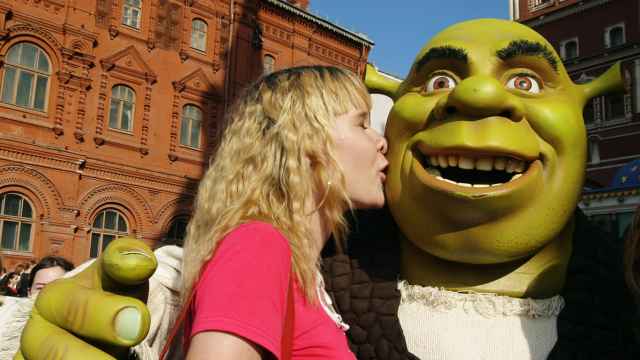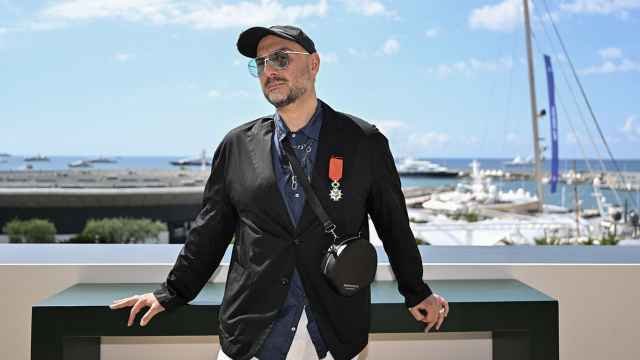I say "the odd souvenirs" because the objects of my topic this week are random — whatever I could put my hands on quickly. But we could just as well leave the "the" out and call this piece "odd theater souvenirs" – because what theater souvenir isn't going to be odd?
I'm not talking about programs or picture post cards, all of which I have written about in this space in the past. This time I mean the stuff you wouldn't expect. And let me say right away: None of this is proof that I am a collector. I am a pack rat.
The idea for this piece arose about a week ago as I sat in row 8a at the Chekhov Moscow Art Theater watching a dramatization of Mikhail Bulgakov's novel "The Master and Margarita." There is a famous scene in that novel where Woland, Satan, takes over a variety theater and works black magic on the performers and audience. He cuts the head off an annoying MC, entices people to strip off their clothes and throws tons of money at them. It doesn't all happen quite like that, but you get the picture.
At the Art Theater the money-tossing scheme was handled nicely. All of a sudden the air above the audience was filled with fluttering orange pieces of paper that looked suspiciously like 5,000 ruble notes as they descended. A chuckling murmur ran through the crowd and people turned their gaze away from the stage and began making plans to spear one of those little bills. I did too. And, harkening back to my old baseball days, I snagged one when it was still in flight.
The theater had printed up a convincing stash of counterfeit money. Nobody will ever be able to spend it (unless someone's great-grandchildren sell it at auction as a historical rarity). The bills are significantly bigger than the real thing, although that's not the main difference. The amount, borrowing the name of a letter in the Russian alphabet that hasn't been used since the Revolution, is listed as "Yat Thousand Rubles," and the figure at the top of the bill is quite clearly listed as "0000." Nicest of all, perhaps, is that the bill pictures Mikhail Bulgakov sitting atop Moscow with a distant image of the moon hanging over his left shoulder.
As I walked out of the theater I slipped my unit of Bulgakov bucks into my program and there it will stay until dust consumes it, I presume.
As I say, this got me thinking. So I rummaged around in my study and found something I was pretty sure I remembered having – a deck of cards issued specially for the premiere Oleg Menshikov's production of "The Gamblers" in 2002. These aren't playing cards, although the box that holds them suggests they are. No, these are more like baseball cards with pictures and autographs of the actors, production crew and sponsors on one side, and humorous or inspirational commentary on the backsides.
My favorite commentary is on the back of Alexander Usov's card (he is pictured in the upper left in one of the photos in the gallery above): "Damn! Smack up against Gogol again!" This is a quote from a hilarious short text called "Pushkin and Gogol" by the absurdist Daniil Kharms. In it, Pushkin and Gogol walk around a room, constantly running into and tripping over each other. This may have little to do with Menshikov's production of Gogol's "The Gamblers," but it is funny. And it is one of the reasons I still have my copy of this odd deck of cards.
In early 1997 I attended one of the most memorable shows I have seen in Moscow. (It opened in 1996 but I was a latecomer.) The full title was "Two Trees. The Tour of the Grand Royal Lilikan Theater in Russia." It was the brainchild of Ilya Epelbaum and Maya Krasnopolskaya of the Ten, or Shadow, Theater. Everything about this show was not just small – it was minuscule. I remember 12 spectators cramming into a cubicle to watch a tiny, manic and hilarious puppet show about some overwrought national legend told in mock Wagnerian terms. But that little performance, which ran about 30 minutes, was only part of the evening, which included "video" showings (drawings on scrolls that someone backstage turned by hand), a museum excursion through the artifacts of the "Grand Royal Lilikan Theater," and, of course, a trip to the theater café.
Thumbnail sandwiches were exactly that – the size of your thumbnail. Programs measured 10 x 7 centimeters. The books on sale – collections of Lilikan poetry and folklore – were smaller yet, measuring in at 5 x 4 cm. Best of all was the Lilikan money you had to exchange for in order to purchase items at the café or museum checkout stand. I no longer recall what the exchange rate was (I think you could make your own), but the Lil, or, as it is listed on the actual bills in the Lilikan language – "odein liles des lilikanes howi" – was the smallest item of all at 4 ½ x 3 ½ cm.
Yes, you guessed it, I still have all these items (aside from the sandwich). You can see some of them in the photo gallery above, too. The money, a one Lil bill, is pictured in the upper left corner.
A Message from The Moscow Times:
Dear readers,
We are facing unprecedented challenges. Russia's Prosecutor General's Office has designated The Moscow Times as an "undesirable" organization, criminalizing our work and putting our staff at risk of prosecution. This follows our earlier unjust labeling as a "foreign agent."
These actions are direct attempts to silence independent journalism in Russia. The authorities claim our work "discredits the decisions of the Russian leadership." We see things differently: we strive to provide accurate, unbiased reporting on Russia.
We, the journalists of The Moscow Times, refuse to be silenced. But to continue our work, we need your help.
Your support, no matter how small, makes a world of difference. If you can, please support us monthly starting from just $2. It's quick to set up, and every contribution makes a significant impact.
By supporting The Moscow Times, you're defending open, independent journalism in the face of repression. Thank you for standing with us.
Remind me later.






